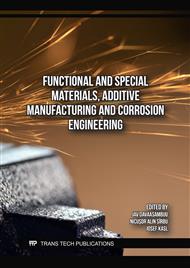p.47
p.57
p.63
p.71
p.81
p.89
p.97
p.105
p.115
Characterization of Low- and High-Calcium Pond Ashes and their Applicability for the Preparation of Alkali-Activated Pastes
Abstract:
Depending on the collecting methods, coal combustion by-products are usually divided into fly ash, bottom ash, and flue gas desulfurization product. Because they are a hazardous dust source, they are often stored underwater in ponds or lagoons and are called pond ash. In this investigation, the pond ashes from Ulaanbaatar's 4th TPS (thermal power station) and Erdenet’s TPS were characterized by XRF, XRD, BET, PSD, SEM and TEM. The pond ash of the 4th TPS contains more than 20% calcium oxide, while Erdenet’s TPS contains around 4% calcium oxide. PSD of the 4th TPS shows a bimodule distribution with a maximum of 36 and 260 mm, while Erdenet's pond ash shows an unimodal distribution with a maximum of 74 mm. The main crystalline compounds of the 4th TPS pond ash were quartz, calcite, hematite, albite, while in the Erdenet pond ash were quartz, mullite, magnetite, and calcite. The mineralogical composition of the pond ashes depends on the used coal type, the power plant’s working principle and the duration of time inside the ash pond. The alkali-activated binder prepared from these pond ashes demonstrated a weak compressive strength of around 1.5-2.5 MPa after 7 days. Notably, the high-calcium pond ash-based alkali-activated paste exhibited slightly higher mechanical properties than the low-calcium pond ash-based paste. The weak mechanical properties of the pond ash-based alkali-activated materials are related to both pond ashes’ porous and high-surface microstructure. High calcium pond ashes could exhibit a partial calcium silicate formation reaction, which is the reason for the higher mechanical properties than low calcium pond ash-based alkali-activated pastes. Furthermore, a brief mechanical activation of these pond ashes for 20 min slightly improved their mechanical properties, reaching up to 3.75 MPa.
Info:
Periodical:
Pages:
115-121
Citation:
Online since:
November 2025
Authors:
Price:
Сopyright:
© 2025 Trans Tech Publications Ltd. All Rights Reserved
Share:
Citation:


